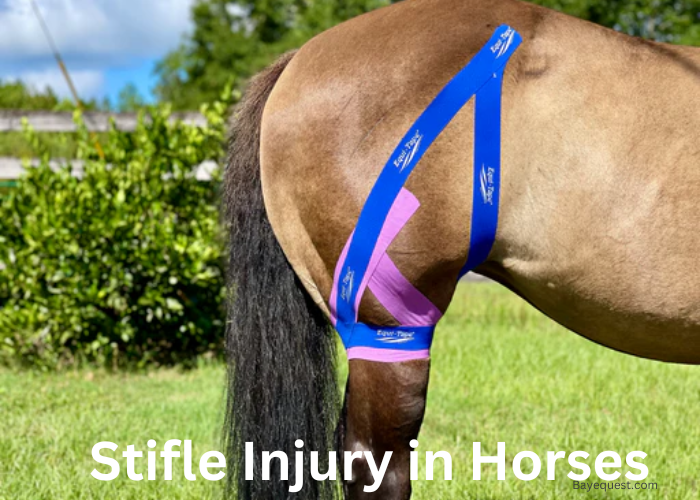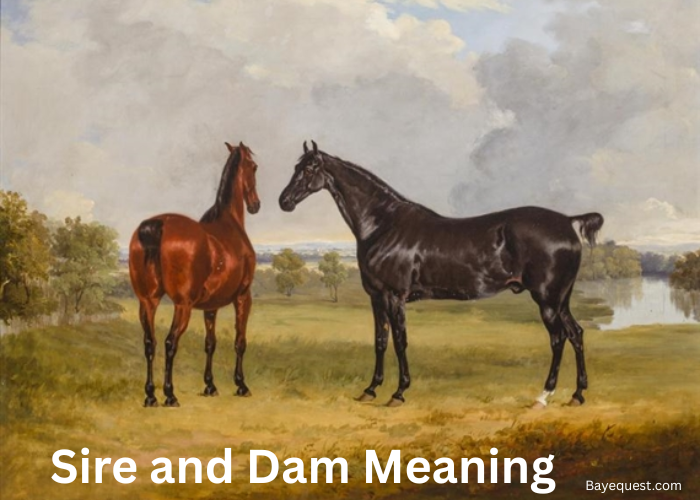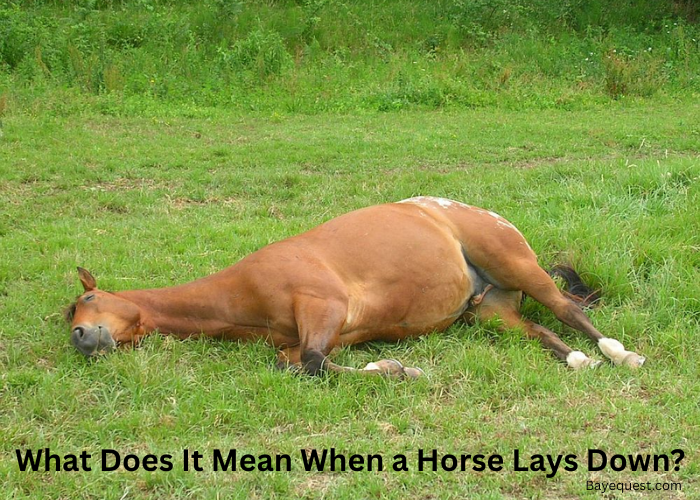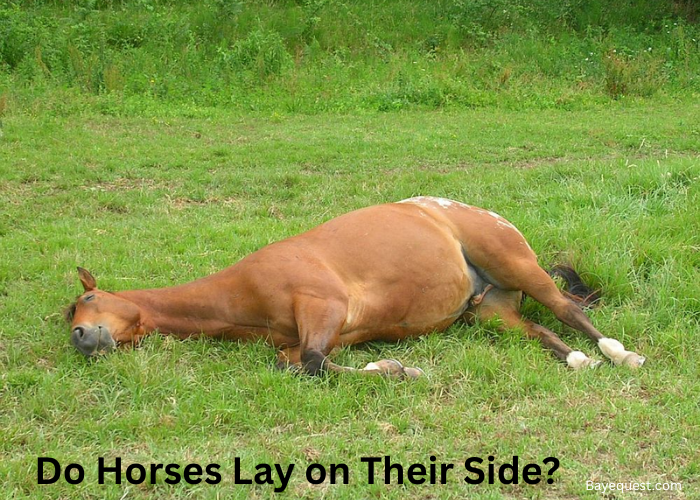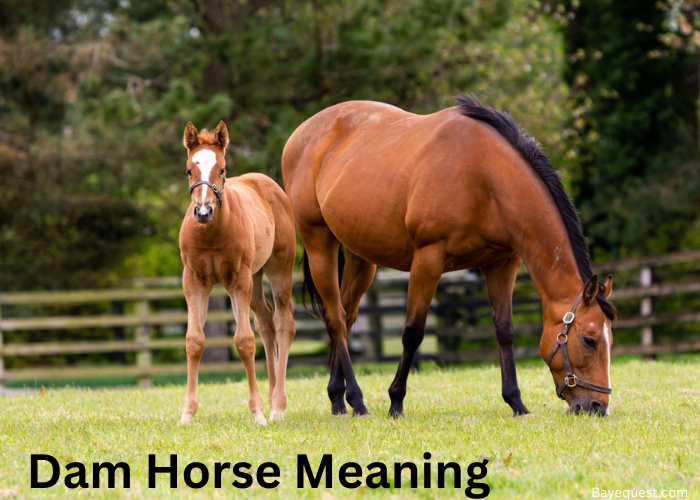A stifle injury can change everything for your horse. One day they’re moving fine. The next, they’re stiff, sore, or even limping.
The stifle joint is complex. It plays a big role in how your horse moves, especially at speed. When something goes wrong here, it’s easy to mistake it for another issue.
That’s why understanding the signs matters. Early treatment can make a big difference.
In this post, we’ll explain everything about stifle injury in horses, including the signs and how to help your horse recover.
Anatomy of the Stifle Joint
The stifle joint is a critical part of a horse’s hind limb, essential for movement and stability. It is the largest joint in their body and is often compared to the human knee.
The joint connects three main bones: the femur, which forms the upper part; the tibia, which supports the lower part; and the patella, or kneecap, which protects the front of the joint.
Inside the joint, cartilage cushions the bones and reduces friction during movement.
Strong ligaments stabilize the stifle, including cruciate ligaments that prevent the femur and tibia from shifting out of place.
The patellar ligaments allow horses to “lock” their legs, helping them stand while resting.
Surrounding muscles, like the quadriceps and hamstrings, power the joint, while tendons connect these muscles to the bones.
A joint capsule filled with fluid surrounds the stifle, keeping it lubricated.
This complex structure enables smooth, powerful movements but also makes the joint prone to injuries if strained or overworked.
Stifle Vs Human Knee
The stifle joint in horses and the human knee have many similarities but also key differences.
Both joints are made up of three main bones: the femur, tibia, and patella. They function as hinge-like joints, allowing flexion and extension.
Strong ligaments, like the cruciate and collateral ligaments, stabilize both joints and prevent unwanted movement.
Both also have cartilage that cushions the bones and a joint capsule filled with fluid to reduce friction and protect the joint.
Despite these similarities, the stifle joint is uniquely adapted for a horse’s needs. It has three patellar ligaments that allow horses to “lock” the joint.
This feature, known as the stay apparatus, helps horses stand for long periods without muscle fatigue.
In contrast, the human knee has only one patellar ligament and cannot lock in the same way.
The stifle also supports a much larger weight load because it propels the horse during movement.
The human knee is more versatile in its range of motion. It allows slight rotation in addition to flexion and extension, which is useful for activities like walking, running, and kneeling.
The stifle is designed for power and stability, making it essential for a horse’s speed and endurance.
These differences reflect the specific roles each joint plays in the lives of horses and humans.
Both joints are prone to injuries, but the causes differ. Stifle injuries in horses often occur from overuse, trauma, or degenerative conditions.
In humans, knee injuries are common in sports and may involve ligament tears or meniscus damage.
While the structures of the stifle and knee are similar, their functions and vulnerabilities are shaped by the needs of their respective species.
What is Stifle Injury in Horses?
A stifle injury in horses is any damage or problem that affects the stifle joint in their hind leg.
The stifle joint is similar to a human knee and is made up of bones, ligaments, tendons, and cartilage.
It allows the horse to bend and extend its leg, making it essential for walking, running, and jumping.
When this joint is injured, it can disrupt the horse’s movement and overall health.
Stifle injuries can include tears or strains in the ligaments, damage to the cartilage, fractures in the bones, or inflammation in the joint.
These injuries may happen suddenly due to trauma, such as a fall or collision, or develop over time from overuse, improper training, or joint diseases like arthritis.
Young horses can also experience stifle issues if their joint doesn’t develop correctly.
The term “stifle injury” covers a wide range of conditions, from minor strains to severe structural damage.
Types of Stifle Disorders
1. Upward Fixation of the Patella (UFP)
Upward fixation of the patella occurs when the patella (kneecap) locks in place. This prevents the horse from bending its hind leg normally.
The condition happens when the ligaments supporting the patella are too loose or weak.
It’s common in young horses, unconditioned horses, or those with weak quadriceps muscles.
Signs include a dragging hind leg, stiffness, or difficulty moving. Sometimes, the leg locks completely in an extended position.
UFP can range from mild to severe. Mild cases may resolve with exercise to strengthen the muscles.
Severe cases may require veterinary treatment, including injections or surgery. Early conditioning and proper fitness can help prevent this condition.
2. Osteochondritis Dissecans (OCD)
Osteochondritis dissecans (OCD) is a developmental disorder of the cartilage in the stifle joint.
It occurs when cartilage fails to form properly, leading to loose fragments of cartilage or bone within the joint.
This condition often affects young, rapidly growing horses, especially those on imbalanced diets.
OCD causes pain, swelling, and lameness, particularly after exercise. Horses with OCD may show stiffness or an unwillingness to move.
Treatment depends on severity. Mild cases may improve with rest and dietary adjustments.
Severe cases may need surgery to remove loose fragments. Managing the horse’s growth, weight, and nutrition can help reduce the risk of OCD.
3. Cruciate Ligament Injuries
Cruciate ligament injuries involve damage to the ligaments that stabilize the stifle joint.
These ligaments keep the femur and tibia in place during movement. Injuries occur due to trauma, such as a fall, slip, or excessive strain.
Signs include lameness, joint swelling, and instability in the hind leg. Horses may struggle to bear weight on the affected leg.
Diagnosis usually requires imaging, such as X-rays or ultrasounds. Treatment often includes rest, anti-inflammatory medications, and physical therapy.
In severe cases, surgery may be necessary. Recovery can take months, and proper care is essential to prevent reinjury.
4. Meniscal Injuries
Meniscal injuries affect the menisci, which are cartilage structures in the stifle joint. The menisci act as shock absorbers and help stabilize the joint.
Tears or damage to the menisci often result from trauma or excessive strain during exercise.
Symptoms include lameness, swelling, and difficulty flexing the hind leg. The horse may avoid putting weight on the affected leg.
Diagnosis involve a veterinary exam and imaging tests. Treatment depends on the severity of the injury.
Rest, anti-inflammatory drugs, and controlled rehabilitation are common approaches. Severe cases may require surgery.
5. Septic Arthritis
Septic arthritis is an infection in the stifle joint. It usually occurs after an injury, surgery, or injection that allows bacteria to enter the joint.
This condition causes severe inflammation, pain, and lameness. The joint may feel warm and swollen.
Horses with septic arthritis often show extreme discomfort and may refuse to bear weight on the affected leg.
Treatment includes draining the infected joint, antibiotics, and anti-inflammatory medications.
Recovery can be slow, and long-term care may be needed to restore joint function.
6. Arthritis (Degenerative Joint Disease)
Arthritis in the stifle joint is a chronic condition caused by wear-and-tear or inflammation.
Over time, the cartilage in the joint breaks down, leading to pain and stiffness. Arthritis is common in older horses or those with a history of joint injuries.
Symptoms include reduced range of motion, stiffness, and difficulty performing normal tasks like turning or jumping.
Diagnosis involves physical exams and imaging, such as X-rays. Treatment focuses on managing symptoms and slowing progression.
Anti-inflammatory drugs, joint supplements, and physical therapy are commonly used. In severe cases, injections or surgery may be recommended.
7. Fractures
Fractures in the stifle joint involve breaks in the bones, such as the femur, tibia, or patella.
These injuries are caused by severe trauma, such as a fall, kick, or collision.
Symptoms include severe pain, swelling, and an inability to bear weight on the affected leg.
Fractures require immediate veterinary attention. Diagnosis is made using imaging like X-rays.
Treatment depends on the type and severity of the fracture. Options include rest, immobilization, or surgery to repair the bone.
Recovery can be lengthy, and strict management is needed to avoid complications.
8. Soft Tissue Strains and Tears
Soft tissue strains and tears involve damage to the ligaments, tendons, or muscles around the stifle joint.
These injuries often occur due to overuse, sudden trauma, or poor footing. Horses with soft tissue injuries may show lameness, stiffness, or swelling around the stifle.
They may also resist bending or flexing the hind leg. Diagnosis involves a physical exam and sometimes imaging like ultrasounds.
Treatment includes rest, anti-inflammatory medications, and controlled exercise during recovery.
Severe tears may require additional interventions, such as physical therapy or regenerative treatments.
Gradual conditioning and good footing can help prevent these types of injuries.
Signs and Symptoms of Stifle Lameness
Stifle lameness can affect a horse’s ability to move and perform daily activities. The symptoms often vary depending on the severity and type of stifle injury.
Here are the most common signs to watch for:
1. Lameness or limping. The horse may favor one leg or avoid putting weight on the affected hind limb.
2. Stiffness. Horses with stifle issues may appear stiff, especially after rest or inactivity. Stiffness often worsens during cold weather or after heavy work.
3. Swelling or heat. The stifle joint may become swollen, and the area can feel warm to the touch.
4. Difficulty flexing the hind leg. The horse may struggle to bend or extend the affected leg fully.
5. Dragging or toe scuffing. The horse may drag its hind toes or show abnormal hoof wear due to improper gait.
6. Reluctance to move or perform. Horses may resist walking, trotting, or performing normal tasks.
7. Changes in behavior. The horse may seem irritable or unwilling to cooperate during riding or handling.
8. Abnormal gait. The horse’s gait may appear uncoordinated or uneven, particularly at faster paces.
9. Muscle loss. Over time, the muscles around the stifle and hindquarters may weaken due to reduced use.
Risk Factors and Causes of Stifle Injury
Here are the key factors that contribute to stifle injuries.
1. Trauma or accidents
Trauma from falls, slips, collisions, or kicks can injure the stifle joint.
Sudden twisting movements during activities like running or turning can strain ligaments or damage cartilage. Hard impacts can also fracture the bones in the joint.
2. Overuse or strain
Excessive workload, such as intense training or jumping, can overstrain the stifle joint.
This repeated stress weakens the joint’s ligaments, tendons, and cartilage, especially in poorly conditioned horses.
3. Poor conformation
Horses with structural issues, like straight hind legs, place abnormal stress on the stifle joint.
This uneven pressure increases the risk of strain, ligament injuries, and cartilage damage over time.
4. Developmental issues
Young horses with improperly developed stifle joints are prone to conditions like OCD.
This occurs when cartilage fails to form correctly, leading to joint instability and pain.
5. Degenerative joint disease (Arthritis)
Wear and tear over time can cause arthritis in the stifle joint.
Horses with previous injuries or those in intense work are at higher risk of developing this painful, chronic condition.
6. Poor hoof care
Improper hoof trimming or uneven hooves can affect weight distribution, placing extra strain on the stifle.
This imbalance can lead to ligament injuries and joint inflammation over time.
7. Poor training or riding practices
Training on hard or uneven surfaces or overworking young horses can damage the stifle joint.
Incorrect riding techniques or poor management during exercise also contribute to joint stress.
8. Excessive weight or obesity
Overweight horses place extra pressure on their stifle joints. This additional weight increases the likelihood of ligament strain, cartilage damage, and inflammation.
9. Weak muscles
Weak hind leg muscles, especially in the quadriceps, fail to support the stifle joint effectively.
This lack of muscle strength makes the joint more vulnerable to injuries during movement.
10. Infection
Infections, such as septic arthritis, occur when bacteria enter the stifle joint through wounds, injections, or surgical procedures.
These infections cause severe inflammation and joint damage, requiring immediate treatment.
How to Diagnose a Stifle Injury
Diagnosing a stifle injury in horses requires careful observation and veterinary assessment.
Below are the steps involved in identifying a stifle injury:
1. Observe the horse’s movement
Look for signs of lameness, stiffness, or difficulty in movement. Pay attention to abnormal gait, reluctance to move, or dragging of the hind toes.
These symptoms often indicate stifle problems.
2. Perform a physical examination
A veterinarian will palpate the stifle joint to check for swelling, heat, or pain.
They may flex and extend the leg to assess the range of motion and identify areas of discomfort.
3. Conduct diagnostic imaging
X-rays or ultrasounds are commonly used to visualize the joint’s internal structures.
These tools help detect bone fractures, ligament tears, or cartilage damage. In severe cases, an MRI may be required for a detailed view.
4. Use nerve blocks
A vet may use local anesthesia (nerve blocks) to pinpoint the location of the pain. This helps confirm whether the stifle joint is the source of the lameness.
5. Joint fluid analysis
If infection is suspected, the vet may extract and test joint fluid. This can confirm conditions like septic arthritis or inflammation caused by trauma.
6. Assess the horse’s history
The horse’s recent activities, training intensity, or past injuries can provide clues about the cause of the stifle problem. This information helps guide the diagnostic process.
Treatment of Stifle Injury in Horses
Treating stifle injuries depends on the type and severity of the condition.
Modern veterinary medicine offers a range of options, from conservative care to advanced regenerative therapies.
Below is an explanation of common treatments:
1. Arthroscopy
Arthroscopy is a minimally invasive surgical procedure used to diagnose and treat stifle injuries.
A small camera is inserted into the joint to visualize the damage.
During the procedure, veterinarians can remove loose cartilage, repair ligament tears, or clean the joint.
Arthroscopy is commonly used for conditions like osteochondritis dissecans (OCD) and meniscal injuries.
It offers faster recovery and less pain compared to open surgery.
2. Desmotomy
Desmotomy involves cutting one of the patellar ligaments to relieve upward fixation of the patella (UFP).
This procedure is used when conservative treatments, like exercise and conditioning, fail to resolve the condition.
By cutting the ligament, the patella can move more freely, reducing stiffness and lameness.
This is usually a last resort for severe cases.
3. Corrective shoeing
Corrective shoeing helps improve the horse’s balance and reduce strain on the stifle joint.
Farriers use special shoes or trims to align the hoof and improve weight distribution.
For horses with conformation issues or stifle injuries, corrective shoeing can provide significant relief and support the recovery process.
4. Estrogen
Estrogen therapy is sometimes used to treat upward fixation of the patella (UFP).
Estrogen strengthens the ligaments around the stifle by improving their elasticity.
This treatment is often combined with exercise and conditioning to build muscle strength and support joint stability.
5. Interleukin-1 Receptor Antagonist Protein (IRAP)
IRAP is a regenerative therapy used to treat joint inflammation and prevent cartilage degeneration.
It works by blocking interleukin-1, a protein that causes inflammation in the joint.
IRAP is injected directly into the stifle joint, reducing pain and promoting healing.
6. Platelet-Rich Plasma (PRP)
PRP therapy involves injecting a concentrated solution of the horse’s own platelets into the stifle joint.
Platelets contain growth factors that promote tissue repair and reduce inflammation.
PRP is commonly used for ligament and tendon injuries, as well as cartilage damage. It helps accelerate healing and improve joint function.
7. Stem Cell Treatments
Stem cell therapy is a cutting-edge treatment for stifle injuries.
Stem cells are injected into the joint to regenerate damaged tissues, including cartilage and ligaments.
This therapy is beneficial for chronic conditions like arthritis or severe ligament injuries.
Stem cells can improve healing and restore joint health, making it a popular choice for long-term recovery.
Prognosis of Stifle Injuries in Horses
The prognosis for stifle injuries in horses depends on how serious the injury is and the treatment used.
Mild injuries, like minor ligament strains, often heal well, with most horses (over 90%) fully recovering after rest and care.
Moderate injuries, such as partial tears or mild arthritis, have a fair chance of recovery, with around 70–85% of horses able to return to work.
Severe injuries, like complete ligament tears or fractures, have a lower chance of recovery, with only 40–60% regaining full function.
Early treatment gives the best chance of success, but serious or chronic injuries may need long-term care to manage.
Read also: Prognosis of Ringone in Horses.
How to Prevent Stifle Lameness in Horses
Preventing stifle lameness in horses requires proper care, management, and training.
Here are some key steps to reduce the risk of stifle injuries:
1. Regular conditioning and exercise
Proper conditioning helps build strong muscles around the stifle joint.
Exercises like hill work, trotting poles, and swimming can strengthen the hindquarters and improve joint stability.
2. Maintain healthy weight
Excess weight places extra stress on the stifle joint.
Keeping your horse at a healthy weight reduces the strain on its joints and lowers the risk of injuries. Provide a balanced diet to maintain proper body condition.
3. Ensure proper hoof care
Regular trimming and shoeing keep hooves balanced, which helps distribute weight evenly.
Uneven hooves can cause additional strain on the stifle joint, leading to lameness.
4. Provide adequate rest
Allow the horse sufficient rest between workouts, especially after intense activity. Rest gives the stifle joint time to recover and prevents overuse injuries.
5. Avoid training on poor surfaces
Hard, slippery, or uneven ground can put unnecessary strain on the stifle joint.
Train on safe, level surfaces to protect the joint from trauma and excessive wear.
6. Focus on balanced workouts
Avoid repetitive movements that strain the same muscles and joints.
Vary exercises to build overall strength and flexibility, reducing the likelihood of stifle problems.
7. Address conformation issues
Horses with poor conformation are more prone to stifle lameness.
Work with a vet or farrier to address conformation issues early and reduce joint stress.
8. Regular veterinary checkups
Routine vet checkups can help identify early signs of stifle issues.
Early detection allows for timely treatment, preventing minor problems from becoming severe.
Supplements for Horses Stifle Injury
Below are key supplements that may benefit horses with stifle injuries:
1. Glucosamine
Glucosamine supports cartilage repair and helps maintain joint health.
It works by stimulating the production of glycosaminoglycans, which are essential for cartilage structure and function.
2. Chondroitin Sulfate
Chondroitin helps reduce cartilage breakdown and promotes joint lubrication.
It works well when combined with glucosamine to support overall joint health and mobility.
3. Hyaluronic Acid (HA)
Hyaluronic acid is a natural component of joint fluid.
It helps maintain joint lubrication, reduces inflammation, and improves the horse’s comfort during movement.
4. MSM (Methylsulfonylmethane)
MSM is a natural sulfur compound that reduces inflammation and supports connective tissue repair.
It also helps improve joint flexibility and reduces stiffness.
5. Omega-3 Fatty Acids
Omega-3s, found in flaxseed or fish oil, have anti-inflammatory properties.
They can help reduce swelling and improve joint function in horses with stifle injuries.
6. Collagen
Collagen supports the health of cartilage, tendons, and ligaments. It aids in tissue repair and helps strengthen the stifle joint after an injury.
7. Vitamin C
Vitamin C is an antioxidant that supports collagen production and helps reduce inflammation.
It aids in the recovery of soft tissue injuries in the stifle joint.
8. Devil’s Claw or Boswellia
These herbal supplements have natural anti-inflammatory properties and can help manage pain in horses with joint injuries.
9. Silicon
Silicon supports the development and maintenance of strong connective tissues, including cartilage and bone, which are essential for joint health.
10. Joint-Specific Blends
Many equine joint supplements combine glucosamine, chondroitin, MSM, and hyaluronic acid for comprehensive joint support.
These blends are convenient and effective for managing stifle injuries.
FAQs
Can a horse recover from a stifle injury?
Yes, a horse can recover from a stifle injury, but the outcome depends on the severity of the injury and the treatment provided. Mild injuries often heal completely with rest and proper rehabilitation. Moderate injuries can have a good recovery rate with treatments. Severe injuries may require surgery and extended recovery time.
How do you exercise a horse with stifle problems?
Exercise for a horse with stifle problems should focus on strengthening the hindquarters and improving joint stability. Start with controlled, low-impact activities like hand-walking or walking on flat, even ground. Gradually introduce hill work, as walking uphill strengthens the quadriceps and stifle muscles. Trotting over ground poles can also improve range of motion and coordination.
Stifle Joint in Horses: Conclusion
Stifle injuries can feel overwhelming, but with the right care, your horse has a good chance to recover.
Early diagnosis, proper treatment, and consistent rehabilitation are the keys to success.
Whether it’s rest, therapy, or advanced treatments like PRP or stem cells, every step you take helps your horse heal.
Don’t forget the importance of prevention—good conditioning, hoof care, and smart training can go a long way.
Keep a close eye on your horse’s movement and act fast if something seems off. A healthy stifle means a happy, active horse.




